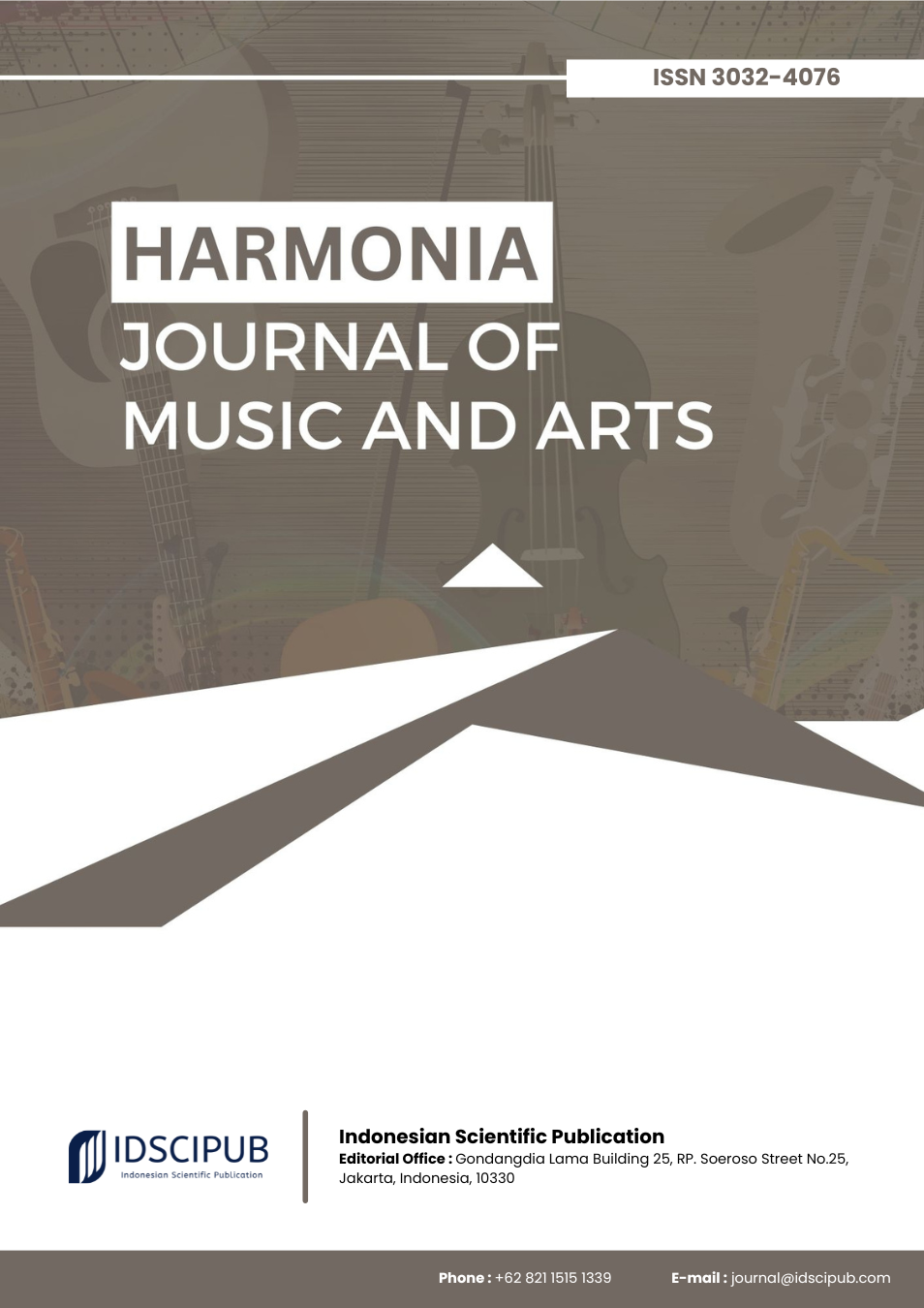Harmonic Poetics and Vocal Subtlety in Karambangan: Interpreting Pamona Musical Aesthetics
DOI:
https://doi.org/10.61978/harmonia.v2i4.1017Keywords:
Karambangan, Pamona Music, Vocal Interpretation, Kayori, Indigenous Harmony, Ethnomusicology, Cultural PedagogyAbstract
Karambangan is a traditional vocal genre of the Pamona people in Central Sulawesi, Indonesia, blending poetic kayori with guitar based harmonic textures. This study aims to analyze the vocal interpretation strategies employed by Karambangan performers, focusing on the integration of harmony, diction, and vocal affect within cultural and pedagogical contexts.
Using a multidisciplinary approach, the research combines ethnographic fieldwork, harmonic transcription, phonetic analysis, and cultural interpretation. Data were collected through audio recordings, kayori texts, and interviews with performers. Harmonic progressions were mapped, vocal timbre and vibrato were measured, and rhetorical features in lyrics were analyzed.
Findings reveal that Karambangan vocalists emphasize emotional nuance through vibrato restraint, nasal resonant timbre, and precise prosodic alignment. Harmonic structures often based on three chord cycles and supported by alternate guitar tunings offer a stable platform for expressive delivery. Kayori lines are vocally interpreted through dynamic shaping, rhetorical timing, and culturally informed diction. The study also discusses the pedagogical value of these techniques and the ethical considerations of transitioning the genre from ritual to stage.
Karambangan emerges as a genre of artistic and cultural significance, where voice serves not only as a musical tool but also as a moral and spiritual practice. The research contributes a genre specific model for vocal interpretation in indigenous traditions and highlights the importance of culturally embedded music education.
References
Baker, C. P., Sundberg, J., Purdy, S. C., Rakena, T. O., & Sylvia H. de S. Leão. (2024). CPPS and Voice-Source Parameters: Objective Analysis of the Singing Voice. Journal of Voice, 38(3), 549–560. https://doi.org/10.1016/j.jvoice.2021.12.010 DOI: https://doi.org/10.1016/j.jvoice.2021.12.010
Baughman, M. (2019). Mentorship and Learning Experiences of Preservice Teachers as Community Children’s Chorus Conductors. Journal of Music Teacher Education, 29(2), 38–52. https://doi.org/10.1177/1057083719876116 DOI: https://doi.org/10.1177/1057083719876116
Bedoya, D., Arias, P., Rachman, L., Liuni, M., Canonne, C., Goupil, L., & Aucouturier, J. (2021). Even Violins Can Cry: Specifically Vocal Emotional Behaviours Also Drive the Perception of Emotions in Non-Vocal Music. Philosophical Transactions of the Royal Society B Biological Sciences, 376(1840). https://doi.org/10.1098/rstb.2020.0396 DOI: https://doi.org/10.1098/rstb.2020.0396
Bremmer, M., & Nijs, L. (2020). The Role of the Body in Instrumental and Vocal Music Pedagogy: A Dynamical Systems Theory Perspective on the Music Teacher’s Bodily Engagement in Teaching and Learning. Frontiers in Education, 5. https://doi.org/10.3389/feduc.2020.00079 DOI: https://doi.org/10.3389/feduc.2020.00079
Buse, J., & Roessner, V. (2016). Neural Correlates of Processing Harmonic Expectancy Violations in Children and Adolescents With OCD. Neuroimage Clinical, 10, 267–273. https://doi.org/10.1016/j.nicl.2015.12.006 DOI: https://doi.org/10.1016/j.nicl.2015.12.006
Craton, L. G., Lee, J. H., & Krahe, P. M. (2019). It’s Only Rock ‘N Roll (But I Like It): Chord Perception and Rock’s Liberal Harmonic Palette. Musicae Scientiae, 25(1), 92–110. https://doi.org/10.1177/1029864919845023 DOI: https://doi.org/10.1177/1029864919845023
Crespo-Bojorque, P., Cauvet, É., Pallier, C., & Toro, J. M. (2024). Recognizing Structure in Novel Tunes: Differences Between Human and Rats. Animal Cognition, 27(1). https://doi.org/10.1007/s10071-024-01848-8 DOI: https://doi.org/10.1007/s10071-024-01848-8
Curran, G., & Radhakrishnan, M. (2021). The Value of Ethnographic Research on Music: An Introduction. The Asia Pacific Journal of Anthropology, 22(2–3), 101–118. https://doi.org/10.1080/14442213.2021.1913511 DOI: https://doi.org/10.1080/14442213.2021.1913511
Goldman, A., Jackson, T. A., & Sajda, P. (2018). Improvisation Experience Predicts How Musicians Categorize Musical Structures. Psychology of Music, 48(1), 18–34. https://doi.org/10.1177/0305735618779444 DOI: https://doi.org/10.1177/0305735618779444
Hackworth, R. S. (2021). Vocal Health Implications for Music Teachers: A Literature Review. Update Applications of Research in Music Education, 42(1), 12–21. https://doi.org/10.1177/87551233211061119 DOI: https://doi.org/10.1177/87551233211061119
Hinkley, S. P. (2023). Vocal Modeling: A Review of Literature. Update Applications of Research in Music Education, 42(2), 23–30. https://doi.org/10.1177/87551233221146285 DOI: https://doi.org/10.1177/87551233221146285
Hu, Y. (2022). The Innovative Path of Diversified Vocal Music Education Reform in Colleges and Universities Under the Advanced Educational Concepts of China and the West. Applied Mathematics and Nonlinear Sciences, 9(1). https://doi.org/10.2478/amns.2021.2.00296 DOI: https://doi.org/10.2478/amns.2021.2.00296
Irawati, E. (2021). Transmission of Resilience Learning in the Context of Formal Education an Ethnomusicological Review. Linguistics and Culture Review, 5(S3), 1040–1053. https://doi.org/10.21744/lingcure.v5ns3.1664 DOI: https://doi.org/10.21744/lingcure.v5nS3.1664
Jiang, K. (2023). An Introduction to the Innovative Path and Exploration of the Teaching Reform of Ethnic Vocal Music. Applied Mathematics and Nonlinear Sciences, 9(1). https://doi.org/10.2478/amns.2023.2.01607 DOI: https://doi.org/10.2478/amns.2023.2.01607
Kleinsmith, A. L., Friedman, R., & Neill, W. T. (2016). Exploring the Impact of Final Ritardandi on Evaluative Responses to Cadential Closure. Psychomusicology Music Mind and Brain, 26(4), 346–357. https://doi.org/10.1037/pmu0000159 DOI: https://doi.org/10.1037/pmu0000159
Lahdelma, I., & Eerola, T. (2019). Exposure Impacts the Pleasantness of Consonance/Dissonance but Not Its Perceived Tension. https://doi.org/10.31234/osf.io/fmxpw DOI: https://doi.org/10.31234/osf.io/fmxpw
Li, Y. (2024). The Possibility of the Application of Modern Vocal Music Technology in Vocal Music Education / La Potencial Aplicación De Las Nuevas Tecnologías De La Música Vocal en La Enseñanza De La Música Vocal. Culture and Education, 36(3), 660–685. https://doi.org/10.1177/11356405241268984 DOI: https://doi.org/10.1177/11356405241268984
Liu, H., & Guo, W. (2025). Effectiveness of AI‐Driven Vocal Art Tools in Enhancing Student Performance and Creativity. European Journal of Education, 60(1). https://doi.org/10.1111/ejed.70037 DOI: https://doi.org/10.1111/ejed.70037
Loni, D. Y., & Subbaraman, S. (2019). Robust Singer Identification of Indian Playback Singers. Eurasip Journal on Audio Speech and Music Processing, 2019(1). https://doi.org/10.1186/s13636-019-0153-0 DOI: https://doi.org/10.1186/s13636-019-0153-0
Ma, Y. (2024). Diversified Optimization of Vocal Singing Teaching Mode in Colleges and Universities Under Multi-Sensory Audiovisual Integration. Applied Mathematics and Nonlinear Sciences, 9(1). https://doi.org/10.2478/amns-2024-1959 DOI: https://doi.org/10.2478/amns-2024-1959
Millican, J. S., & Forrester, S. H. (2019). Music Teacher Rankings of Selected Core Teaching Practices. Journal of Music Teacher Education, 29(1), 86–99. https://doi.org/10.1177/1057083719867682 DOI: https://doi.org/10.1177/1057083719867682
Milne, A. J., Smit, E. A., Sarvasy, H. S., & Dean, R. T. (2023). Evidence for a Universal Association of Auditory Roughness With Musical Stability. Plos One, 18(9), e0291642. https://doi.org/10.1371/journal.pone.0291642 DOI: https://doi.org/10.1371/journal.pone.0291642
Pogalin, D. V. R., & Lestari, D. T. (2023). Unveiling the Melodic Traditions of Mahzani: An Ethnomusicological Investigation of Tombulu Music in Indonesia’s Minahasa Region. Gelar Jurnal Seni Budaya, 21(1), 36–46. https://doi.org/10.33153/glr.v21i1.5282 DOI: https://doi.org/10.33153/glr.v21i1.5282
Prieske, S. (2019). Der Ausnahmezustand Als Regel. Die Musikforschung, 72(4), 323–332. https://doi.org/10.52412/mf.2019.h4.38 DOI: https://doi.org/10.52412/mf.2019.H4.38
Recek, Ž. M., Zala, R., Laura, Š., Petra, Š., Martin, V., Brina, Z., & Anka, S. O. (2021). Which Chord Progressions Satisfy Us the Most? The Effect of Expectancy, Music Education, and Pitch Height. Interdisciplinary Description of Complex Systems, 19(4), 580–590. https://doi.org/10.7906/indecs.19.4.9 DOI: https://doi.org/10.7906/indecs.19.4.9
Ritchie, L., & Sharpe, B. T. (2021). Music Student’s Approach to the Forced Use of Remote Performance Assessments. Frontiers in Psychology, 12. https://doi.org/10.3389/fpsyg.2021.641667 DOI: https://doi.org/10.3389/fpsyg.2021.641667
Scalici, G. (2019). Music and the Invisible World: Music as a Bridge Between Different Realms. Aijmt, 11(1). https://doi.org/10.56883/aijmt.2019.237 DOI: https://doi.org/10.56883/aijmt.2019.237
Shin, H., & Fujioka, T. (2018). Effects of Visual Predictive Information and Sequential Context on Neural Processing of Musical Syntax. Frontiers in Psychology, 9. https://doi.org/10.3389/fpsyg.2018.02528 DOI: https://doi.org/10.3389/fpsyg.2018.02528
Sun, L., Chen, F., & Yang, Y. (2020). Tension Experience Induced by Nested Structures in Music. Frontiers in Human Neuroscience, 14. https://doi.org/10.3389/fnhum.2020.00210 DOI: https://doi.org/10.3389/fnhum.2020.00210
Sun, L., Liu, F., Zhou, L., & Jiang, C. (2017). Musical Training Modulates the Early but Not the Late Stage of Rhythmic Syntactic Processing. Psychophysiology, 55(2). https://doi.org/10.1111/psyp.12983 DOI: https://doi.org/10.1111/psyp.12983
Tang, X., & Choatchamrat, S. (2024). Singing Techniques and Teaching Methods of Singer Liao Changyong in Chinese Opera Vocal Performance in a Sociological Context. Ijsasr, 4(5), 359–370. https://doi.org/10.60027/ijsasr.2024.4812 DOI: https://doi.org/10.60027/ijsasr.2024.4812
Thorpe, L., Cousins, M., & Bramwell, R. (2019). Implicit Knowledge and Memory for Musical Stimuli in Musicians and Non-Musicians. Psychology of Music, 48(6), 836–845. https://doi.org/10.1177/0305735619833456 DOI: https://doi.org/10.1177/0305735619833456
Zhang, J.-L. (2024). The Role of Innovative Musical Education in the Development of Social Skills in Children and Adolescents. Journal of Psychologists and Counsellors in Schools, 34(4), 463–477. https://doi.org/10.1177/20556365241290871 DOI: https://doi.org/10.1177/20556365241290871
Zhou, L., Liu, F., Jiang, J., Jiang, H., & Jiang, C. (2019). Abnormal Neural Responses to Harmonic Syntactic Structures in Congenital Amusia. Psychophysiology, 56(9). https://doi.org/10.1111/psyp.13394 DOI: https://doi.org/10.1111/psyp.13394
Zhu, J., Chen, X., Chen, F., Zhang, C., Shao, J., & Wiener, S. (2023). Distributional Learning of Musical Pitch Despite Tone Deafness in Individuals With Congenital Amusia. The Journal of the Acoustical Society of America, 153(5), 3117. https://doi.org/10.1121/10.0019472 DOI: https://doi.org/10.1121/10.0019472
Zorzal, R. C., & Quiles, O. L. (2017). Teacher–student Physical Contact as an Approach for Teaching Guitar in the Master Class Context. Psychology of Music, 47(1), 69–82. https://doi.org/10.1177/0305735617737154 DOI: https://doi.org/10.1177/0305735617737154






